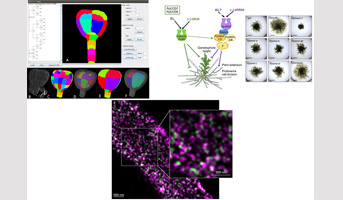IJPB Highlights from Life Sciences at Paris-Saclay University
PLATFORM FOCUS: The dSTORM-type super-resolution imaging offers a new dimension in the study of molecular structures at the nanometric scale!, 22/2/24
The “Cytology/Imaging” platform OV-Cyto covers various aspects of microscopy, from brightfield observation to advanced fluorescence analysis in confocal microscopy, with a focus on plant samples. It provides a range of microscopes, sample preparation equipment necessary for observation, and the required expertise. What's new on the platform? Since late 2023, it has been equipped with a brand-new microscope enabling dSTORM-type super-resolution imaging in 3D and multi-color. Acquired as part of the ERC STORMtheWALL project (Kalina Haas, "Primary Cell Wall" PAR team, IJPB news), this equipment will allow for the tracking of 3D structures of individual molecules and cellular dynamics.
> More
> See also IJPB news 29/11/23
SMXL proteins suppress the growth of mosses through an ancestral signaling pathway, preserved in terrestrial plants, but the signal remains to be discovered, 30/1/24
In a study published in the Plant Cell, Ambre Guillory and her colleagues from the "Signaling of Allelopathic Compounds and Strigolactones" SAS team, in collaboration with scientists from the Institute of Chemistry of Natural Substances (ICSN), characterized the SMXL gene homologs in the moss Physcomitrium patens (4 genes PpSMXLA-D). In this non-vascular plant, strigolactones (hormones involved in the control of the aerial architecture of vascular plants) suppress the growth and branching of filaments and promote the development of gametophores (leafy stems). Another signaling pathway, called the KL pathway, has opposite effects on moss development. The study of P. patens mutants in the PpSMXL genes compared to known results in vascular plants has highlighted an ancestral signaling pathway.
> More
> See also IJPB news 25/1/24
TreeJ: an interactive ImageJ plugin for reconstructing cell lineage from static images, 5/12/23
Researchers from the "Modeling and Digital Imaging" MiN team and the MaIAGE unit working on the variability of cellular organization of the model plant Arabidopsis thaliana embryos have developed an interface to help build, modify, and save a cell lineage. The interface is accessible in ImageJ/Fiji, an image processing software that is very easy to use and widely utilized in the scientific community. Several application examples are presented in the article published in Plant Methods.
> More
Research developed at the Institute Jean-Pierre Bourgin for Plant Sciences.
Back
